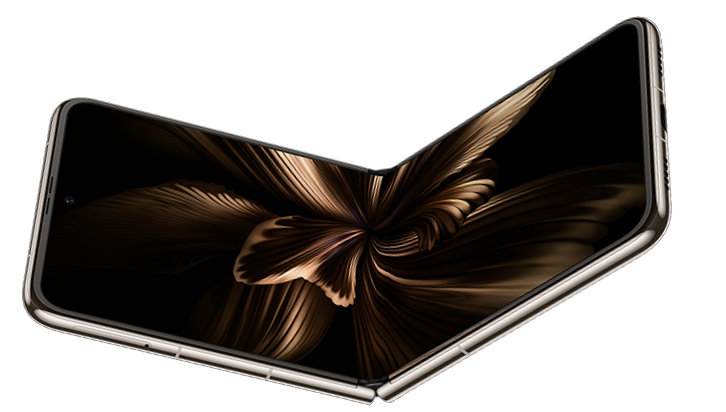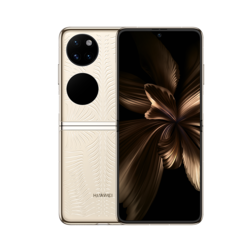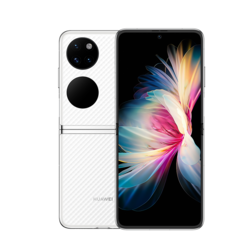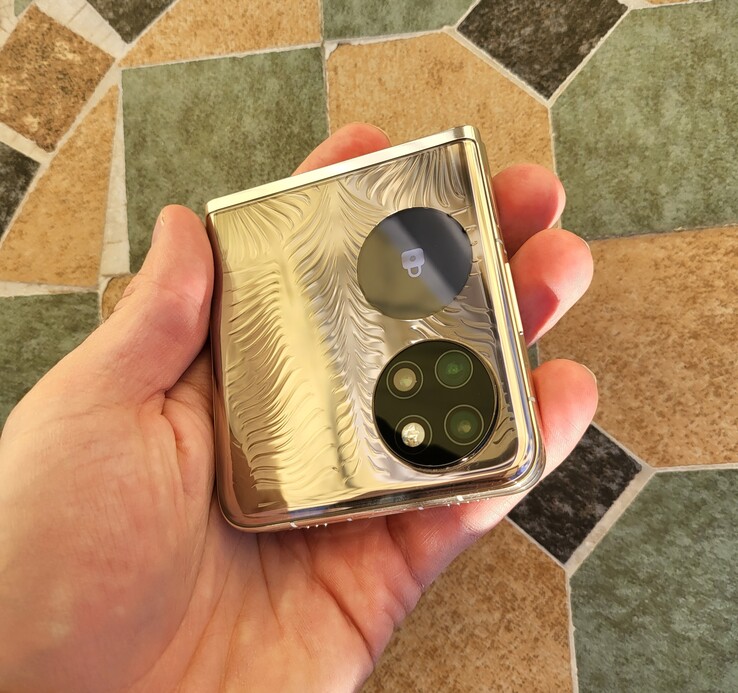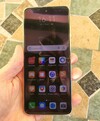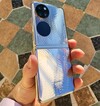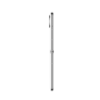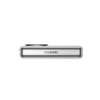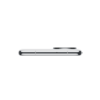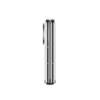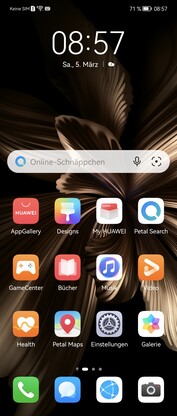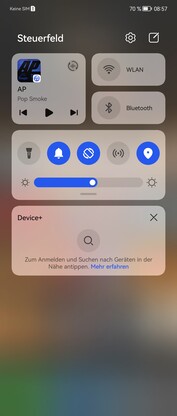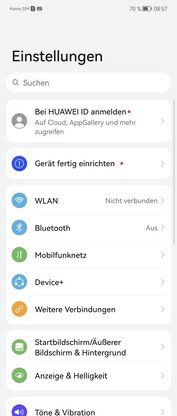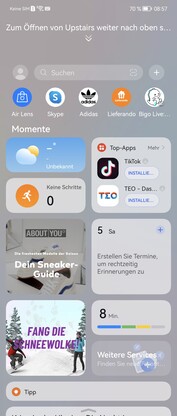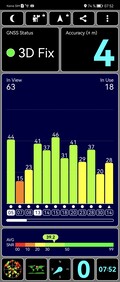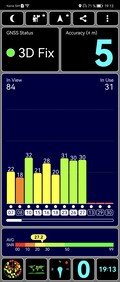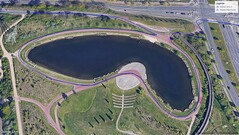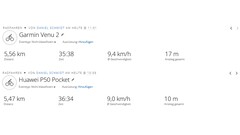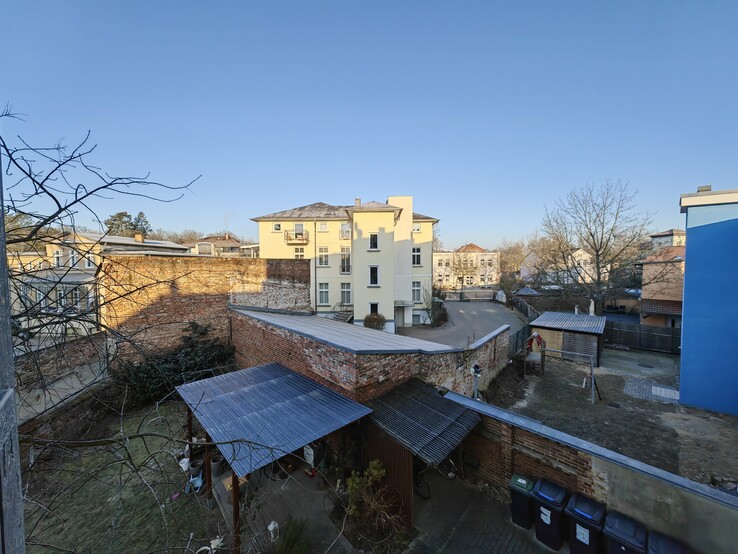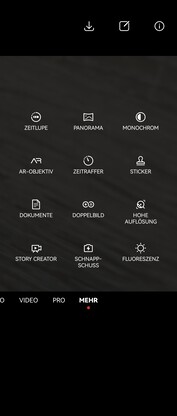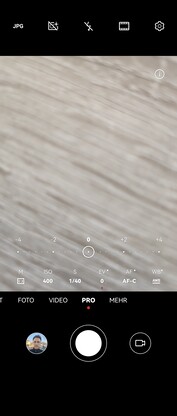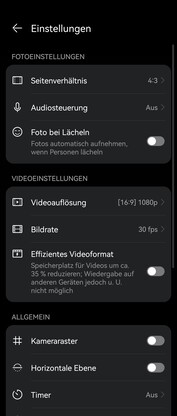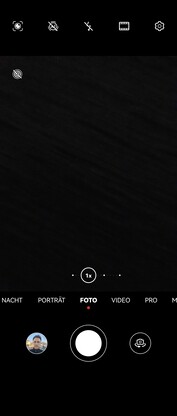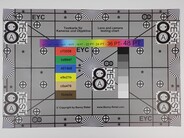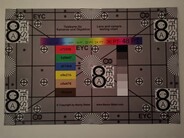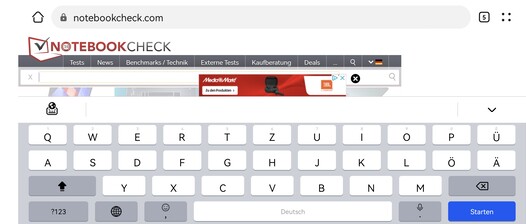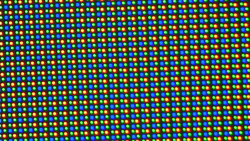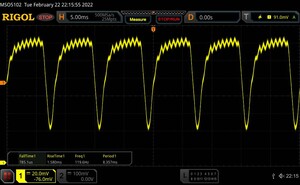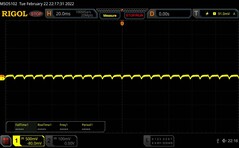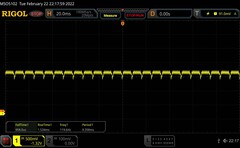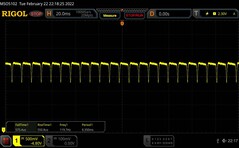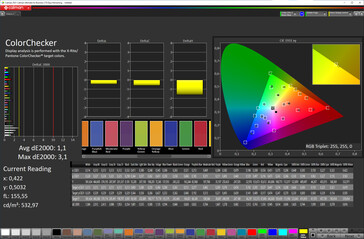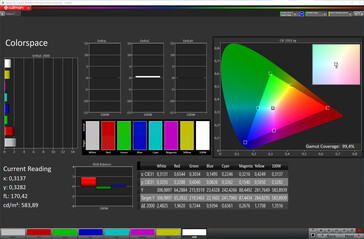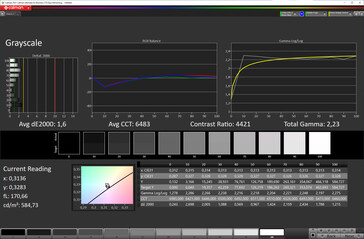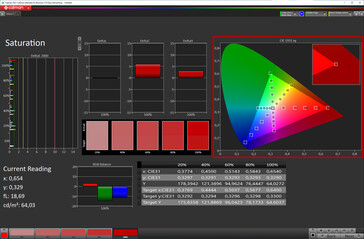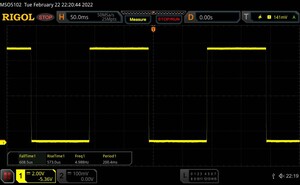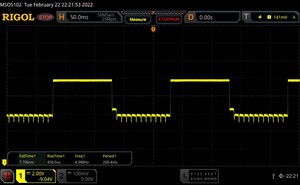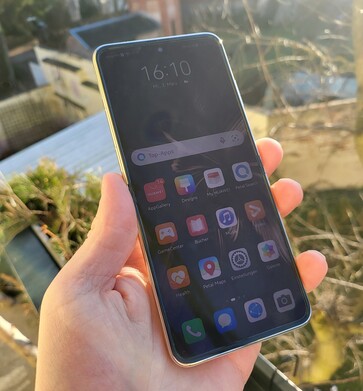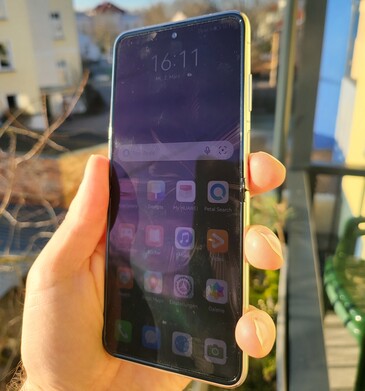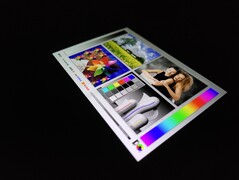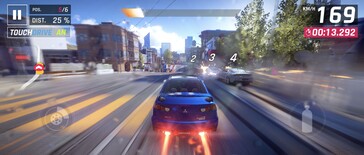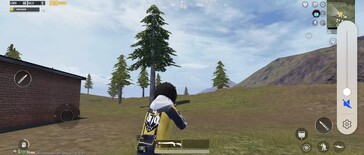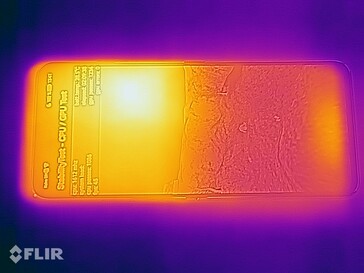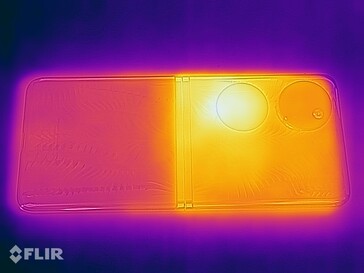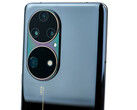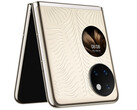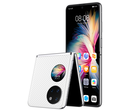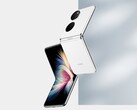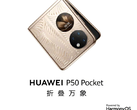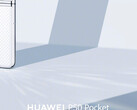Huawei P50 Pocket review: The folding smartphone brings some positive and negative surprises
After Huawei already offered a large foldable smartphone with the Mate X series, the Chinese manufacturer now catches up with Samsung and the Z Flip3 5G. The P50 Pocket is as compact as the foldable from the Koreans. While it uses a Snapdragon 888, it is a 4G version.
Similar to the Z Flip3 5G, the Huawei smartphone uses a foldable AMOLED panel with a maximum refresh rate of 120 Hz and also includes a small display on the exterior. While there is a Premium Edition with 12 GB of RAM and 512 GB of storage, the "regular" Pocket model has to be content with 8 GB of working memory and 256 GB of storage.
Possible Competitors in Comparison
Rating | Date | Model | Weight | Drive | Size | Resolution | Price |
|---|---|---|---|---|---|---|---|
| 86.1 % v7 (old) | 03 / 2022 | Huawei P50 Pocket SD 888 4G, Adreno 660 | 190 g | 512 GB UFS 3.1 Flash | 6.90" | 2790x1188 | |
| 86.3 % v7 (old) | 09 / 2021 | Samsung Galaxy Z Flip3 5G SD 888 5G, Adreno 660 | 183 g | 128 GB UFS 3.1 Flash | 6.70" | 2640x1080 | |
| 87.6 % v7 (old) | 02 / 2022 | Xiaomi 12 Pro SD 8 Gen 1, Adreno 730 | 204 g | 256 GB UFS 3.1 Flash | 6.73" | 3200x1440 | |
| 88.6 % v7 (old) | 06 / 2022 | OnePlus 9 Pro SD 888 5G, Adreno 660 | 197 g | 256 GB UFS 3.1 Flash | 6.70" | 3216x1440 |
Case - P50 Pocket with a punch hole
The light, 190-gram (~6.7 oz) P50 Pocket shows high-quality workmanship. At about 15 mm (~0.6 in) when folded up, it looks significantly thicker than a classic smartphone, but it still turns out comfortably compact at 87 x 76 mm (~3.4 x 3 in). In contrast to the Galaxy Z Flip3, in closed state the P50 Pocket doesn't have a noticeable gap between the two halves of the display, but it also doesn't have any IPX8 rating to protect against water getting inside.
Like its large sibling or Oppo's Find N, the P50 Pocket also uses a waterdrop hinge, which allows for a display inside that doesn't have much of a crease. In addition to the reduction of the display crease and the flat closing mechanism, the hinge also brings a disadvantage. When it is only half opened, the P50 Pocket does not allow you keep it stable with variable opening angles. Overall, the folding resistance feels significantly stronger than even in the Mate Xs, but on the other hand, a Z Flip 5G offers a more high-quality impression of the folding mechanism.
In addition to the large, 6.9-inch foldable OLED panel, the Huawei smartphone also offers a round display in the cover. Among other things, the small AMOLED panel allows you to read notifications using service widgets or control the music player without having to open the foldable smartphone.
Equipment - Huawei smartphone with Nano Memory
In our test unit, the internal storage offers a capacity of 512 GB, with only 464 GB of this remaining available to the user in the state of delivery. Using an inserted Nano Memory card (NM), you can move various files such as photos or music to the external medium, allowing you to expand the UFS storage by up to 256 GB.
You can also connect peripheral devices such as USB sticks to the USB C port, which supports the 2.0 standard, by using an OTG adapters. In addition, the USB port supports the DisplayPort 1.2 standard. The P50 Pocket also allows wireless transfer of the display contents to external monitors via Miracast. Thanks to a sunscreen detection, the folding smartphone can also optionally check the face of the user to tell whether they have applied sufficient sunscreen or need to reapply more in some spots.
microSD Card Reader
Huawei's inhouse storage card type offers decent read and write speeds, and we measure 38 MB/s and 79 MB/s in the CPD test. In addition, the NM card connection impresses with a solid data transfer rate of about 35 MB/s in our copy test.
| SD Card Reader - average JPG Copy Test (av. of 3 runs) | |
| Huawei P50 Pocket (Huawei NanoMemory) | |
| Sony Xperia Pro-I (Angelbird AV Pro V60) | |
Cross Platform Disk Test (CPDT)
Software - Huawei smartphone with EMUI
Even though the P50 Pocket is equipped with the in-house HarmonyOS in China, in this country, the widely known EMUI version 12, which is based on Android 11, is used.
As is also known, Huawei smartphones don't support Google mobile services and Google apps - or only using some (questionable) workarounds. However, the Huawei AppGallery, alternative app stores such as the Amazon AppStore, as well as the Petal Search function still give a fairly wide range of applications to the P50 Pocket.
Communication and GNSS - P50 Pocket with WiFi 6
The transfer rates with the P50 Pocket in the home network turn out constant. In our WLAN test in combination with our Asus ROG Rapture GT-AXE11000 reference router, the WLAN module, which supports the IEEE-802.11 a/b/g/n/ac/ax standards, impresses with a high speed.
In terms of communication modules, in addition to the fast WLAN, the manufacturer supports Dual SIM as well as Bluetooth version 5.2. An NFC chip for nearfield communication and contactless payment is also included onboard.
While access to the LTE net is supported in many 4G frequency bands, you cannot take advantage of the fast 5G standard.
| Networking | |
| iperf3 transmit AX12 | |
| Samsung Galaxy Z Flip3 5G | |
| OnePlus 9 Pro | |
| iperf3 receive AX12 | |
| Samsung Galaxy Z Flip3 5G | |
| OnePlus 9 Pro | |
| iperf3 receive AXE11000 | |
| Xiaomi 12 Pro | |
| Huawei P50 Pocket | |
| Average of class Smartphone (52 - 1721, n=178, last 2 years) | |
| iperf3 transmit AXE11000 | |
| Xiaomi 12 Pro | |
| Huawei P50 Pocket | |
| Average of class Smartphone (49.8 - 1828, n=178, last 2 years) | |
We evaluate the locating accuracy of our test unit in a practical test, where we record a route in parallel with a Garmin Venu 2 for comparison. The deviations of the route recordings by the P50 Pocket are relatively small, but we can still see some inaccuracies in the recorded route.
Telephone Functions and Voice Quality - Huawei smartphone with a Nano SIM
Cameras - Huawei smartphone with a triple camera system
The ultra-spectrum camera setup consists of a "True Chroma" main camera with a 40-MP resolution, which is supposed to produce recordings with particularly accurate colors. And indeed, our analysis with the ColorChecker Passport is able to confirm a good color accuracy for the Huawei smartphone - with the exception of green tones.
Although the P50 Pocket is a foldable, which puts the focus more on the foldability of the panel, we really like the pictures taken with the main camera. The sharpness and dynamics are on a very good level. The same also goes for the 13-MP ultrawide angle camera, which is able to produce a lot of details.
Thanks to the foldable form factor, you can take selfies with the main camera using the cover screen. As expected, in terms of sharpness and low light performance, the 11-MP camera inside is unable to keep up with this, but it can still take relatively good pictures.
Image comparison
Choose a scene and navigate within the first image. One click changes the position on touchscreens. One click on the zoomed-in image opens the original in a new window. The first image shows the scaled photograph of the test device.
WeitwinkelWeitwinkelLow LightUltraweitwinkelZoom 5x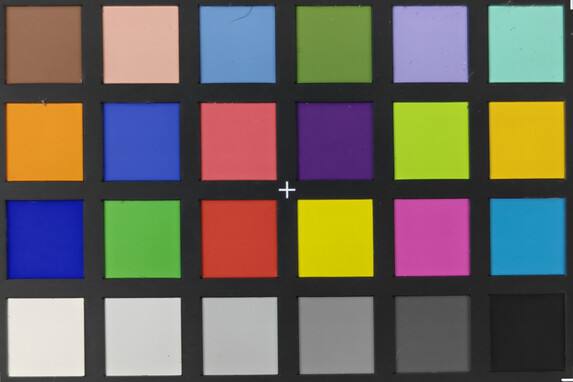
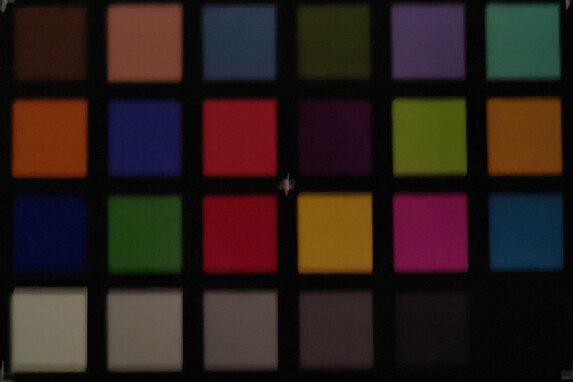
Accessories and Warranty - The Huawei smartphone includes a charger
A USB-C cable and a 40-Watt quick charger are included with the smartphone. The warranty period is 24 months.
Input Devices and Operation - P50 Pocket with Face Unlock
While the outer display is protected by a hardened class cover, the foldable OLED panel with its ultra-thin glass has to be content with a protective foil. On the other hand, the touchscreen with a scanning rate of up to 300 Hz also offers very good sliding characteristics with this, allowing for very accurate operation. Due to the high refresh rate of up to 120 Hz, the system display appears comfortably smooth.
The capacitive fingerprint sensor in the power button responds quickly, recognizing the finger accurately most of the time. Those who want to use their face to unlock the display will also not be disappointed with the Huawei smartphone, since biometrical identification using the face is supported.
Display - Huawei P50 Pocket with 120 Hz
The foldable 6.9-inch OLED panel of the P50 Pocket has a form factor of 21:9, an adaptive refresh rate of 120 Hz, and a resolution of 2790 x 1188 pixels. This results in a high pixel density of more than 400 ppi for the foldable smartphone. At a maximum of 780 cd/m², the display brightness is at a good level that is similar to a Galaxy Z Flip3, but our realistic APL50 measurement also doesn't show a higher brightness (792 cd/m²).
As all OLEDs, the panel of the P50 Pocket also flickers. While the display uses a fairly constant PWM at the minimal brightness level, the amplitude, which is around 120 Hz, varies slightly more at brightness levels above that.
| |||||||||||||||||||||||||
Brightness Distribution: 96 %
Center on Battery: 780 cd/m²
Contrast: ∞:1 (Black: 0 cd/m²)
ΔE ColorChecker Calman: 1.1 | ∀{0.5-29.43 Ø4.77}
ΔE Greyscale Calman: 1.6 | ∀{0.09-98 Ø5}
99.4% sRGB (Calman 2D)
Gamma: 2.23
CCT: 6483 K
| Huawei P50 Pocket Foldable OLED, 2790x1188, 6.9" | Samsung Galaxy Z Flip3 5G AMOLED, 2640x1080, 6.7" | Xiaomi 12 Pro AMOLED, 3200x1440, 6.7" | OnePlus 9 Pro AMOLED, 3216x1440, 6.7" | |
|---|---|---|---|---|
| Screen | -8% | 5% | 6% | |
| Brightness middle (cd/m²) | 780 | 832 7% | 959 23% | 733 -6% |
| Brightness (cd/m²) | 768 | 842 10% | 977 27% | 746 -3% |
| Brightness Distribution (%) | 96 | 97 1% | 96 0% | 97 1% |
| Black Level * (cd/m²) | ||||
| Colorchecker dE 2000 * | 1.1 | 1.9 -73% | 1.1 -0% | 0.95 14% |
| Colorchecker dE 2000 max. * | 3.1 | 3.3 -6% | 3.1 -0% | 2.01 35% |
| Greyscale dE 2000 * | 1.6 | 1.4 12% | 1.9 -19% | 1.7 -6% |
| Gamma | 2.23 99% | 2.1 105% | 2.22 99% | 2.21 100% |
| CCT | 6483 100% | 6453 101% | 6498 100% | 6591 99% |
* ... smaller is better
Screen Flickering / PWM (Pulse-Width Modulation)
| Screen flickering / PWM detected | 119.6 Hz | ||
The display backlight flickers at 119.6 Hz (worst case, e.g., utilizing PWM) . The frequency of 119.6 Hz is very low, so the flickering may cause eyestrain and headaches after extended use. In comparison: 53 % of all tested devices do not use PWM to dim the display. If PWM was detected, an average of 8081 (minimum: 5 - maximum: 343500) Hz was measured. | |||
In our tests with the CalMAN software and a spectral photometer, the display of the foldable smartphone showed itself very well calibrated. The Delta-E values fall within the ideal range (<3), and the color temperature is also right on the spot at about 6500K.
Display Response Times
| ↔ Response Time Black to White | ||
|---|---|---|
| 1.18 ms ... rise ↗ and fall ↘ combined | ↗ 0.573 ms rise | |
| ↘ 0.608 ms fall | ||
| The screen shows very fast response rates in our tests and should be very well suited for fast-paced gaming. In comparison, all tested devices range from 0.1 (minimum) to 240 (maximum) ms. » 5 % of all devices are better. This means that the measured response time is better than the average of all tested devices (20.2 ms). | ||
| ↔ Response Time 50% Grey to 80% Grey | ||
| 8.164 ms ... rise ↗ and fall ↘ combined | ↗ 0.458 ms rise | |
| ↘ 7.706 ms fall | ||
| The screen shows fast response rates in our tests and should be suited for gaming. In comparison, all tested devices range from 0.165 (minimum) to 636 (maximum) ms. » 21 % of all devices are better. This means that the measured response time is better than the average of all tested devices (31.6 ms). | ||
Daylight doesn't pose any problems to the Huawei smartphone. Thanks to the optical nano coating, annoying reflections should be reduced, but in direct sunlight, the reflections visibly limit the readability. However, there is currently no better way with foldable panels including the protective foil. Thanks to the OLED technology used, the viewing angles are at a good level.
Performance - P50 Pocket with a Qualcomm SoC
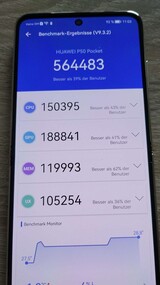
In everyday operation, the Huawei smartphone always runs smoothly and almost without any delays. The system performance is excellent, and applications load very quickly. The reason for this lies in the Snapdragon 888 being used, which integrates a fast primary core based on the ARM Cortex-X1 architecture, three fast Cortex-A78 performance cores, and four Cortex-A55 cores. This is accompanied by an Adreno 660 as the graphics unit.
In our benchmark package, the Qualcomm SoC shows large performance capabilities, but only in the performance mode of the P50 Pocket. However, in that mode, the case of the foldable smartphone also heats up very quickly, leading to throttling and inconsistent values in the benchmark tests. In normal mode, the P50 Pocket only reaches performance values that are not as good when compared to the potential of the Snapdragon 888.
| GFXBench 3.0 | |
| on screen Manhattan Onscreen OGL | |
| Xiaomi 12 Pro | |
| Samsung Galaxy Z Flip3 5G | |
| Average of class Smartphone (18 - 166, n=156, last 2 years) | |
| Average Qualcomm Snapdragon 888 4G (49 - 106, n=3) | |
| OnePlus 9 Pro | |
| Huawei P50 Pocket | |
| 1920x1080 1080p Manhattan Offscreen | |
| Xiaomi 12 Pro | |
| Average of class Smartphone (12 - 606, n=155, last 2 years) | |
| OnePlus 9 Pro | |
| Huawei P50 Pocket | |
| Samsung Galaxy Z Flip3 5G | |
| Average Qualcomm Snapdragon 888 4G (73 - 132, n=3) | |
| GFXBench 3.1 | |
| on screen Manhattan ES 3.1 Onscreen | |
| Xiaomi 12 Pro | |
| Average of class Smartphone (11 - 166, n=156, last 2 years) | |
| Samsung Galaxy Z Flip3 5G | |
| OnePlus 9 Pro | |
| Huawei P50 Pocket | |
| Average Qualcomm Snapdragon 888 4G (19 - 67, n=3) | |
| 1920x1080 Manhattan ES 3.1 Offscreen | |
| Average of class Smartphone (8.4 - 413, n=155, last 2 years) | |
| Xiaomi 12 Pro | |
| Samsung Galaxy Z Flip3 5G | |
| OnePlus 9 Pro | |
| Average Qualcomm Snapdragon 888 4G (52 - 76, n=3) | |
| Huawei P50 Pocket | |
| Jetstream 2 - 2.0 Total Score | |
| Average of class Smartphone (23.8 - 387, n=148, last 2 years) | |
| Xiaomi 12 Pro (Chrome 97) | |
| OnePlus 9 Pro (Microsoft Edge 46) | |
| JetStream 1.1 - Total Score | |
| Samsung Galaxy Z Flip3 5G (Chrome 93) | |
| Xiaomi 12 Pro (Chrome 97) | |
| OnePlus 9 Pro (Microsoft Edge 46) | |
| Huawei P50 Pocket (Huawei Browser 11.1) | |
| Average Qualcomm Snapdragon 888 4G (105.5 - 110.3, n=2) | |
| Speedometer 2.0 - Result 2.0 | |
| Average of class Smartphone (15.2 - 643, n=120, last 2 years) | |
| Xiaomi 12 Pro (Chrome 97) | |
| OnePlus 9 Pro (Microsoft Edge 46) | |
| WebXPRT 3 - Overall | |
| Average of class Smartphone (38 - 380, n=30, last 2 years) | |
| Samsung Galaxy Z Flip3 5G (Chrome 93) | |
| Xiaomi 12 Pro (Chrome 97) | |
| Average Qualcomm Snapdragon 888 4G (101 - 115, n=2) | |
| OnePlus 9 Pro (Microsoft Edge 4689) | |
| Huawei P50 Pocket (Huawei Browser 11.1) | |
| Octane V2 - Total Score | |
| Average of class Smartphone (2228 - 126661, n=195, last 2 years) | |
| Samsung Galaxy Z Flip3 5G (Chrome 93) | |
| Xiaomi 12 Pro (Chrome 97) | |
| OnePlus 9 Pro (Microsoft Edge 46) | |
| Average Qualcomm Snapdragon 888 4G (21748 - 26010, n=3) | |
| Huawei P50 Pocket (Huawei Browser 11.1) | |
| Mozilla Kraken 1.1 - Total | |
| Huawei P50 Pocket (Huawei Browser 11.1) | |
| Average Qualcomm Snapdragon 888 4G (1835 - 1938, n=2) | |
| OnePlus 9 Pro (Microsoft Edge 46) | |
| Xiaomi 12 Pro (Chrome 97) | |
| Average of class Smartphone (257 - 28190, n=155, last 2 years) | |
| Samsung Galaxy Z Flip3 5G (Chrome 93) | |
* ... smaller is better
| Huawei P50 Pocket | Samsung Galaxy Z Flip3 5G | Xiaomi 12 Pro | OnePlus 9 Pro | Average 512 GB UFS 3.1 Flash | Average of class Smartphone | |
|---|---|---|---|---|---|---|
| AndroBench 3-5 | -1% | 49% | 4% | 37% | 66% | |
| Sequential Read 256KB (MB/s) | 1839 | 1620 -12% | 1620 -12% | 1995 8% | 1874 ? 2% | 2246 ? 22% |
| Sequential Write 256KB (MB/s) | 575 | 750 30% | 1465 155% | 769 34% | 1338 ? 133% | 1882 ? 227% |
| Random Read 4KB (MB/s) | 263.5 | 276.6 5% | 324.9 23% | 258.7 -2% | 290 ? 10% | 298 ? 13% |
| Random Write 4KB (MB/s) | 342.1 | 250.6 -27% | 448.9 31% | 254.3 -26% | 357 ? 4% | 346 ? 1% |
Games - The Huawei smartphone knows can be used for gaming
Emissions - Huawei smartphone gets too hot
Temperatures
Under load, the case of the P50 Pocket heats up to various extents in the performance mode. While the maximum temperatures we measure with the Stability Test app are at a rather low level, the heat development during the benchmarks is very pronounced. This quickly leads to overheating of the device and to a drastic reduction of the performance development inside. But even in normal mode, we measure throttling of almost 50%.
(+) The maximum temperature on the upper side is 35.7 °C / 96 F, compared to the average of 35.2 °C / 95 F, ranging from 21.9 to 247 °C for the class Smartphone.
(+) The bottom heats up to a maximum of 34.9 °C / 95 F, compared to the average of 34 °C / 93 F
(+) In idle usage, the average temperature for the upper side is 27.3 °C / 81 F, compared to the device average of 32.9 °C / 91 F.
3DMark Wild Life Stress Test
| 3DMark | |
| Wild Life Stress Test Stability | |
| Samsung Galaxy Z Flip3 5G | |
| OnePlus 9 Pro | |
| Huawei P50 Pocket | |
| Xiaomi 12 Pro | |
| Wild Life Extreme Stress Test | |
| Samsung Galaxy Z Flip3 5G | |
| Huawei P50 Pocket | |
| Xiaomi 12 Pro | |
Speakers
The P50 Pocket uses stereo speakers that are loud and sound really good. Our measurements of the Huawei smartphone show a fairly linear frequency development for the mids and highs, and you can even divine some bass in the sound spectrum.
Those who prefer sound output richer in bass can use a wired or wireless headphone solution. In addition to the USB port, the Bluetooth 5.2 standard is also supported.
Huawei P50 Pocket audio analysis
(+) | speakers can play relatively loud (90.1 dB)
Bass 100 - 315 Hz
(-) | nearly no bass - on average 23% lower than median
(±) | linearity of bass is average (8.2% delta to prev. frequency)
Mids 400 - 2000 Hz
(+) | balanced mids - only 4.1% away from median
(+) | mids are linear (4% delta to prev. frequency)
Highs 2 - 16 kHz
(+) | balanced highs - only 4.5% away from median
(+) | highs are linear (4.8% delta to prev. frequency)
Overall 100 - 16.000 Hz
(±) | linearity of overall sound is average (16.1% difference to median)
Compared to same class
» 5% of all tested devices in this class were better, 4% similar, 90% worse
» The best had a delta of 11%, average was 35%, worst was 134%
Compared to all devices tested
» 25% of all tested devices were better, 5% similar, 70% worse
» The best had a delta of 4%, average was 24%, worst was 134%
Samsung Galaxy Z Flip3 5G audio analysis
(+) | speakers can play relatively loud (88.6 dB)
Bass 100 - 315 Hz
(-) | nearly no bass - on average 27.7% lower than median
(±) | linearity of bass is average (9.3% delta to prev. frequency)
Mids 400 - 2000 Hz
(+) | balanced mids - only 3.6% away from median
(+) | mids are linear (4% delta to prev. frequency)
Highs 2 - 16 kHz
(±) | higher highs - on average 5.5% higher than median
(+) | highs are linear (3.6% delta to prev. frequency)
Overall 100 - 16.000 Hz
(±) | linearity of overall sound is average (18.3% difference to median)
Compared to same class
» 18% of all tested devices in this class were better, 9% similar, 73% worse
» The best had a delta of 11%, average was 35%, worst was 134%
Compared to all devices tested
» 39% of all tested devices were better, 8% similar, 53% worse
» The best had a delta of 4%, average was 24%, worst was 134%
Battery Life - P50 Pocket with 4000 mAh
Power Consumption
The 4000-mAh battery can be recharged from 10 to 100% within about one hour at a maximum of 40 watts. In addition, we measure a quite pronounced power consumption during idle operation.
| Off / Standby | |
| Idle | |
| Load |
|
Key:
min: | |
| Huawei P50 Pocket 4000 mAh | Samsung Galaxy Z Flip3 5G 3300 mAh | Xiaomi 12 Pro 4600 mAh | OnePlus 9 Pro 4500 mAh | Average Qualcomm Snapdragon 888 4G | Average of class Smartphone | |
|---|---|---|---|---|---|---|
| Power Consumption | 41% | 13% | -25% | -4% | -4% | |
| Idle Minimum * (Watt) | 1.33 | 0.46 65% | 0.94 29% | 1.6 -20% | 1.285 ? 3% | 0.847 ? 36% |
| Idle Average * (Watt) | 1.77 | 0.74 58% | 1.24 30% | 2 -13% | 1.955 ? -10% | 1.446 ? 18% |
| Idle Maximum * (Watt) | 1.89 | 0.78 59% | 1.34 29% | 2.4 -27% | 2.05 ? -8% | 1.63 ? 14% |
| Load Average * (Watt) | 4.25 | 4.73 -11% | 5.7 -34% | 6.2 -46% | 4.1 ? 4% | 6.95 ? -64% |
| Load Maximum * (Watt) | 9.19 | 5.89 36% | 8.12 12% | 11 -20% | 9.82 ? -7% | 11.3 ? -23% |
* ... smaller is better
Power Consumption: Geekbench (150 cd/m²)
Power Consumption: GFXBench (150 cd/m²)
Battery Life
In our WLAN test and with 120 Hz, the P50 Pocket only achieves a battery life of about 8 hours, which is below average. We should also mention here that EMUI always terminates our battery test going into standby at a remaining capacity of 10%. This is why we added 44 minutes to our measured runtime of 7 hours and 18 minutes (from 10 to 100%).
| Huawei P50 Pocket 4000 mAh | Samsung Galaxy Z Flip3 5G 3300 mAh | Xiaomi 12 Pro 4600 mAh | OnePlus 9 Pro 4500 mAh | |
|---|---|---|---|---|
| Battery runtime | ||||
| WiFi v1.3 (h) | 8 | 9 13% | 12.8 60% | 16.7 109% |
Pros
Cons
Verdict on the Huawei P50 Pocket
The P50 Pocket gave us some surprises in our test. On the positive side, we can mention the quality of the camera in the back. Compared to our test pictures taken with the Apple iPhone 13 Pro, the photo quality of the P50 Pocket is a real bonus. Surprisingly, Huawei has also managed to fit a powerful, 4000-mAh battery into the slim case of the Pocket, but the battery life is rather disappointing due to the thermal problems.
On the negative side, the large surprise is the performance development. The Snapdragon 888 4G in the P50 Pocket overheats relatively quickly, and even in normal mode with the system related throttling of the Qualcomm SoCs, we measure throttling of 50% at times.
The recommended retail price being much too high spoils the mass appeal of the P50 Pocket.
Before a purchase, those who are interested in a foldable smartphone should consider that a P50 Pocket supports neither Google Services nor the 5G standard due to the US sanctions that still remain in place. But aside from that, the Huawei P50 Pocket offers some interesting equipment. On the other hand, the current prices of the Samsung Galaxy Z Flip3 5G (of about 650 Euros, ~$709) don't turn the purchase of a 1200-Euro (~$1310) foldable from Huawei into a more attractive proposition.
Price and Availability
While the Huawei P50 Pocket is available from Huawei Global in various European, Asian, and other countries, an unlocked international 512-GB version is available from Amazon for $1989 in the US.
Huawei P50 Pocket
- 08/30/2022 v7 (old)
Marcus Herbrich


